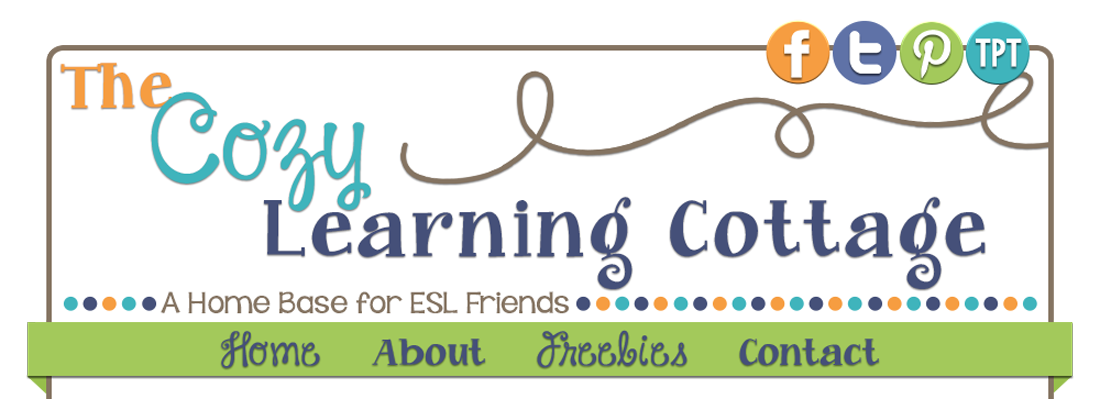Today I'm welcoming Melanie Speros to the Cozy Learning Cottage to tell us about how she uses themes to collaborate between EL teachers and Gen Ed teachers.
I teach kindergarten at an elementary school with a high
population (75%) of English Language Learners (ELL). Many of my students are trying to learn the
academic content and English at the
same time. I support this simultaneous
learning with thematic teaching. If you
are an ESL teacher who provides push-in or pull-out support to students, you
may already be working with themes in your language work. Maybe the general education teachers are
working with themes in their own classrooms.
If we coordinate and use the same themes together, our ELL’s
subject-area learning can reinforce their language development and vice versa.
Using Themes with Beginning
Readers
I realized how useful thematic teaching can be when I was
working with my beginning ELLs. During
guided reading, when I would introduce a new text to my students, I would do a
detailed book introduction. We would
talk about the pictures and practice using the vocabulary and language of the
book, but when it came time to read it, they could not remember the
vocabulary.
One day one of my beginning ELLs was reading a page that
said, “I see the boat.” They stopped at
the word boat and didn’t say
anything. After some prompting (with
some blank stares and no attempts to read the word), I told them “boat.” Then, on the next page, it said “I see the
train.” But again, my student stopped at the word train. With a fluent English
speaker, prompts such as, “Check the picture” or “Make the beginning sound” would
remind students to use all of the information on the page to read the
word. But I realized that prompts like
these are useless if you don’t remember the word train. Even if my student knew to check the picture,
if they could not remember that that thing on the page was called a train in
English, checking the picture would not help them solve the word. Even if my student saw the word train and
knew the /t/ sound, if they didn’t remember the word train the /t/ would not help them.
I started teaching guided reading in themes, particularly
with my beginning ELLs so that my students could use the same vocabulary across
multiple texts. I have seen amazing
progress, lots of confidence, and many smiles as my students now read their
books. Using themes gave them a little
extra support to take on the reading work.
It has been so exciting!
Using Themes
Throughout the School Day
This got me thinking.
What if they saw that same vocabulary during math time when we were
practicing addition story problems? What
if they heard that same vocabulary in our read aloud? What if that was the vocabulary they were
using during our designated ELD time? I
knew that thematic teaching would provide such an important support for my
students.
While vocabulary is only a small piece of ELD, it is the
glue that holds it all together. As an
ESL teacher, if your goal is to work on using prepositional phrases, you would
probably use sentence frames as a scaffold.
But what if the topic you chose was consistent with the read aloud the
students had listened to earlier in the school day, or the same topic in their
guided reading book? What if they had been reading books and solving math word
problems on this topic all week? Your
ELLs would be hearing and practicing the vocabulary all day long! Then, when it came time to practice
prepositional phrases with your sentence frames, your students would be
familiar with the vocabulary, and ready for the new language challenge.
ESL and General
Education Teachers Working Together
Thematic teaching does not need to be complicated or
elaborate. Just collaborate on a
theme. Brainstorm vocabulary (nouns,
verbs, adjectives) and think about areas where the theme may fit into the
curriculum. Don’t worry about fitting it
into every part of your school day. Here
are some ideas for an ocean animal theme:
·
Solve math word problems about ocean animals
·
Use a survey about favorite ocean animals for
sharing during Morning Meeting
·
Read aloud books about ocean animals or use
ocean-themed books in shared reading
·
Find guided reading books about ocean animals
for small group instruction
·
Use ocean animal examples in word study or word
work (e.g. Correct grammar errors in sentences about ocean animals)
·
Write an informational piece about an ocean
animal or write a story with ocean animal characters
·
Do an ocean animal art project
·
Sing songs about ocean animals
What are some themes you have used with your
students? When or how have you
integrated it into the school day?
Melanie Speros is a kindergarten teacher in Southern
California. She believes in the
importance of the home/school connection and using interactive and hands-on
learning to maximize student engagement.
You can find her on labandlibrary.com,
Teachers Pay Teachers, Pinterest, and Periscope.
Pinterest Link: https://www.pinterest.com/labandlibrary/
Periscope: @melanie_speros




